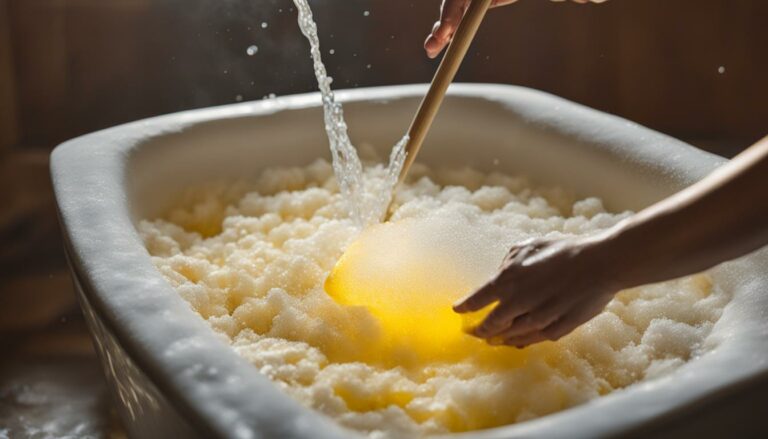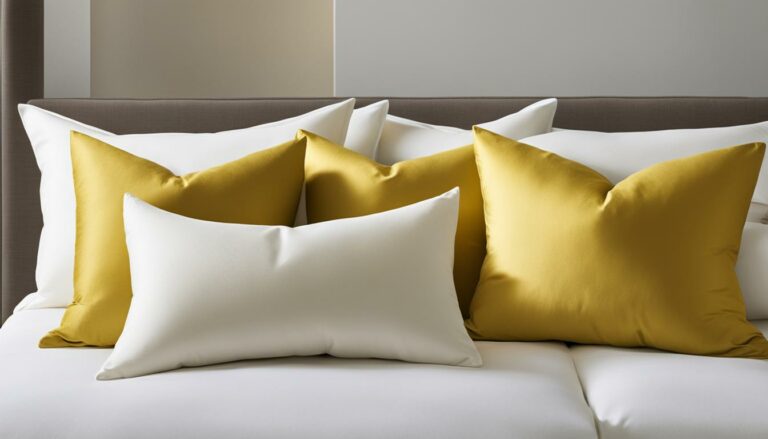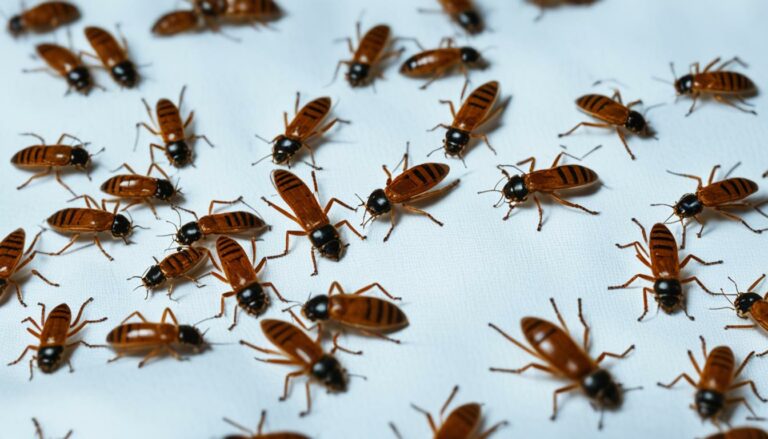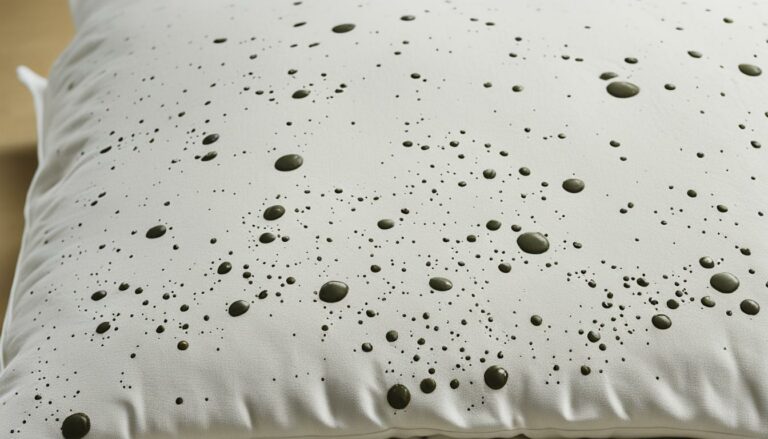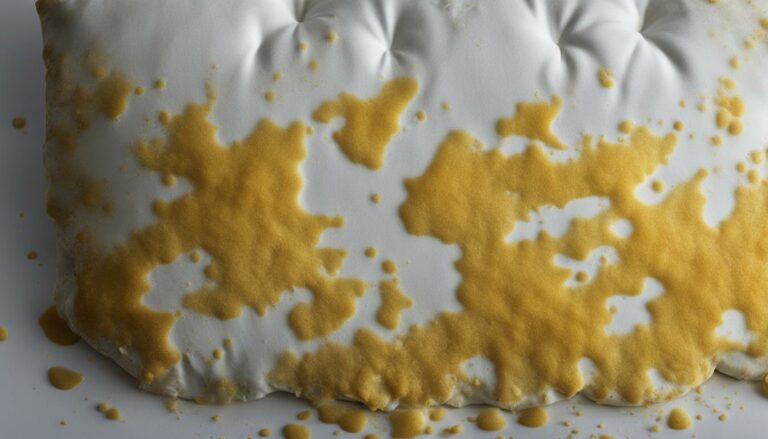Why Are My Pillows Turning Yellow? Find Out Now!
Eric Christie stands as a luminary in the bedding industry, with a career spanning nearly four decades since the early 1980s. His journey through the world of bedding has seen him wear many hats – a manufacturer, designer, and retailer, showcasing his versatility and expertise in Read more...
pillowsandbedsheets.com and its partners may earn a commission if you purchase a product through one of our links
Have you ever wondered why your pillows start developing yellow stains over time? These unsightly discolorations can not only be a cosmetic concern but also indicate potential health risks. Understanding the causes of yellow pillow stains, how to prevent them, and how to remove them is essential for maintaining a clean and healthy sleep environment.
Yellow stains on pillows are primarily caused by the accumulation of moisture from sweat, drool, wet hair, and skincare products. As these substances seep into the pillow fabric, they can create an ideal breeding ground for bacteria and allergens, which can affect not only the appearance of your pillows but also your quality of sleep and overall health.
To prevent yellowing of pillows, it is important to take proactive measures. Using pillow protectors can create an additional barrier between your pillow and moisture, keeping it clean and free from stains. Additionally, sleeping in a cooler room, wearing lighter pajamas, and avoiding going to bed with wet hair can minimize the accumulation of moisture on your pillows.
When yellow stains do occur, it is crucial to know how to remove them effectively. Spot-treating the stains with a suitable cleaning agent and following the care instructions provided by the manufacturer can help diminish the severity of the discoloration. However, it’s important to note that not all pillows can withstand bleaching, so it’s essential to understand the specific care guidelines for your pillow.
Regularly maintaining and replacing your pillows is also vital for promoting clean and healthy sleep. Over time, pillows can accumulate allergens such as dust mites and mildew, leading to potential allergic reactions and other health issues. It is recommended to replace your pillows every one to two years to ensure optimal sleep hygiene.
By taking proper care of your pillows and implementing preventive measures, you can avoid and eliminate yellow stains, creating a cleaner and more comfortable sleep environment. Keeping your pillows clean not only enhances the overall appearance of your bedding but also contributes to better sleep and improved well-being.
Key Takeaways:
- Yellow stains on pillows are caused by the accumulation of moisture from sweat, drool, wet hair, and skincare products.
- Preventing yellow stains can be achieved by using pillow protectors, sleeping in a cooler room, wearing lighter pajamas, and avoiding going to bed with wet hair.
- To remove yellow stains, spot-treat them with a suitable cleaning agent and follow the care instructions provided by the manufacturer.
- Regularly maintaining and replacing your pillows every one to two years is crucial for a clean and healthy sleep environment.
- Clean pillows contribute to better sleep quality, improved well-being, and reduced allergen exposure.
Factors That Turn Pillows Yellow
Pillows can turn yellow due to various factors, with the most common one being the accumulation of moisture. Sweat, drool, wet hair, and skincare products can all contribute to yellow stains on pillows.
The presence of these stains not only affects the appearance of the pillows but can also lead to the growth of bacteria and allergens, potentially impacting sleep quality and overall health.
Preventing and addressing yellowing pillows is crucial for maintaining a clean and healthy sleep environment.
“The yellow stains on my pillows were such an eyesore. I couldn’t figure out why it was happening until I realized that it was mainly due to the perspiration and oils from my hair and face. Taking steps to prevent these stains not only improved the appearance of my pillows but also made me feel more confident about the cleanliness of my bedding.”
– Sarah, a satisfied pillow user
- Moisture accumulation: Sweat, drool, wet hair, and skincare products can contribute to yellow pillow stains. The moisture from these sources seeps into the pillow and can lead to discoloration over time.
- Bacteria and allergens: Yellow stains can harbor bacteria and allergens, which can negatively impact sleep quality and potentially cause health issues for individuals with allergies or sensitivities.
- Material composition: The type of pillow filling and fabric can also affect the likelihood and severity of yellow stains. Some materials may be more prone to discoloration than others.
Understanding these factors can help you take proactive measures to prevent and address yellow stains on your pillows.
Take a look at the following table to understand the causes of yellow stains on pillows:
| Factors | Causes |
|---|---|
| Sweat | The body’s natural perspiration can seep into the pillow. |
| Drool | Drooling during sleep can contribute to yellow stains over time. |
| Wet hair | Sleeping with wet hair can transfer moisture to the pillow. |
| Skincare products | Oils and creams from skincare routines can accumulate on the pillow. |
How to Prevent Yellow Stains on Pillows
Preventing yellow stains on pillows is essential for maintaining their cleanliness and extending their lifespan. By implementing a few simple tips and practices, you can keep your pillows looking fresh and free from discoloration. Here are some effective pillow care tips for preventing yellowing:
- Use a Pillow Protector:
Using a pillow protector is an excellent way to prevent yellow stains. These protective covers act as a barrier between your pillow and moisture, preventing sweat, drool, and skincare products from seeping into the pillow. Pillow protectors are typically made of waterproof or water-resistant materials that are easy to clean and maintain. By using a pillow protector, you can safeguard your pillows from stains and extend their overall lifespan.
- Sleep in a Cooler Room:
High temperatures and excessive humidity can contribute to excessive sweating during sleep, which can lead to yellow stains on pillows. To prevent this, try keeping your bedroom cool by adjusting the thermostat or using a fan. Sleeping in a cooler environment can help reduce the amount of sweat produced, minimizing the risk of yellowing and discoloration.
- Wear Lighter Pajamas:
The type of fabric and color of your pajamas can also affect the moisture level on your pillows. Choose lighter-colored and breathable pajamas made from natural materials like cotton or bamboo. These materials help wick away moisture and allow better airflow, reducing the chances of yellow stains appearing on your pillows.
- Avoid Going to Bed with Wet Hair:
Wet hair can transfer moisture and oils onto your pillows, leading to yellow stains over time. To prevent this, make sure your hair is completely dry before going to bed or use a towel to wrap your hair to absorb any excess moisture. By keeping your pillows dry, you can minimize the risk of yellowing and maintain a cleaner sleep surface.
- Address the Causes of Drooling:
If you tend to drool while sleeping, it’s important to address the underlying causes. Certain sleeping positions or nasal congestion can contribute to excessive drooling. Consider using nasal strips or a nasal spray to improve airflow, or try different sleeping positions to reduce the likelihood of drooling. By reducing drooling, you can prevent excessive moisture from reaching your pillows and avoid yellow stains.
- Avoid Excessive Use of Skincare Products Before Bed:
Skincare products such as creams, lotions, or serums can contain oils and ingredients that can transfer onto your pillowcase, leading to yellow stains. To prevent this, minimize the use of skincare products right before bedtime. Instead, apply these products well in advance to allow adequate time for absorption, or consider using lighter formulas that are less likely to transfer onto your pillows.
By implementing these pillow care tips and practices, you can effectively prevent yellow stains from forming on your pillows. It’s important to maintain a clean sleep environment to promote better sleep quality and overall well-being.
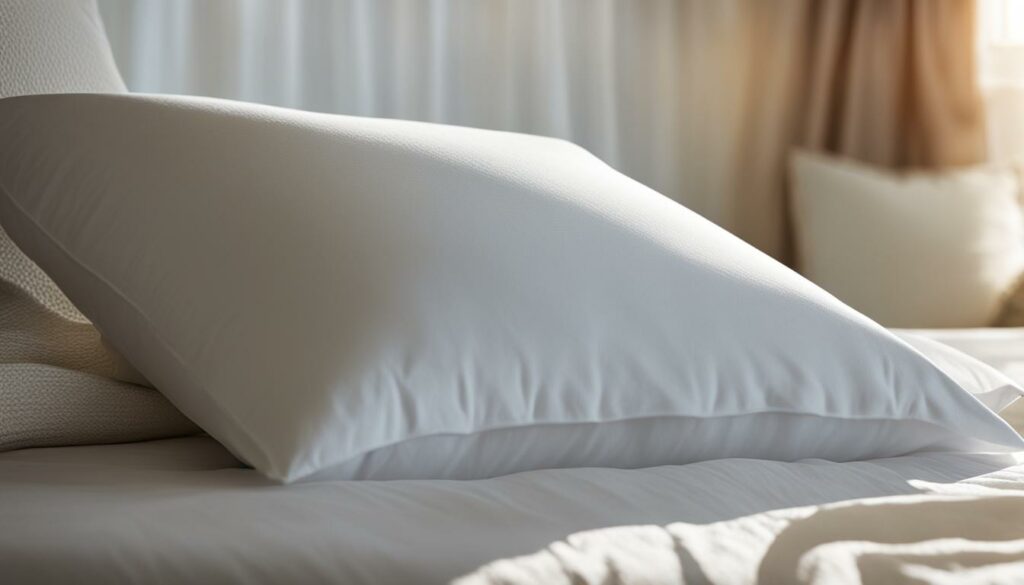
Pillow Care Tips for Preventing Yellowing
| Tips | Description |
|---|---|
| Use a Pillow Protector | Protects the pillow from moisture and stains |
| Sleep in a Cooler Room | Reduces excessive sweating during sleep |
| Wear Lighter Pajamas | Allows better airflow and wicks away moisture |
| Avoid Going to Bed with Wet Hair | Prevents moisture transfer to the pillow |
| Address the Causes of Drooling | Improves airflow and reduces excessive drooling |
| Avoid Excessive Use of Skincare Products Before Bed | Reduces the likelihood of product transfer onto the pillow |
How to Remove Yellow Stains From Pillows
If yellow stains have already formed on your pillows, don’t worry! There are several effective methods to remove them and restore your pillows’ freshness. It’s important to follow the care instructions provided by the manufacturer to avoid damaging the pillow fabric or filling. Here are a few remedies to get rid of those stubborn yellow stains:
- Spot-treating stains: Start by applying a small amount of a mild cleaning agent directly to the stained area. Gently rub the cleaning agent into the fabric using a clean cloth or sponge. Let it sit for a few minutes and then wipe off the cleaning agent with a damp cloth. This method can help reduce the severity of yellow stains.
- Bleaching: Bleaching can be an effective option for removing yellow stains, but it should be used cautiously. Not all pillows can withstand bleach, so it’s essential to check the care guidelines provided by the manufacturer before using this method. If bleach is safe for your pillow, dilute it according to the instructions and soak the stained area. Rinse thoroughly afterward to remove any residual bleach.
- Alternative remedies: If you prefer natural remedies, you can try using a mixture of hydrogen peroxide and baking soda. Create a paste-like consistency by combining the two ingredients and apply it to the yellow stains. Let it sit for about 30 minutes and then rinse off with water. Another option is to sprinkle the stained areas with a mixture of salt and lemon juice, gently rub it in, and allow it to sit for a while before rinsing.
Remember, always check the care instructions for your specific pillow type and fabric before attempting any stain removal techniques. If you’re unsure or hesitant, it’s best to consult with a professional cleaner to ensure the proper treatment of your pillows.
Keeping your pillows clean and free from yellow stains is not only visually appealing but also contributes to a healthier sleep environment. In the next section, we will explore the importance of keeping pillows clean and how it can positively impact your sleep quality.
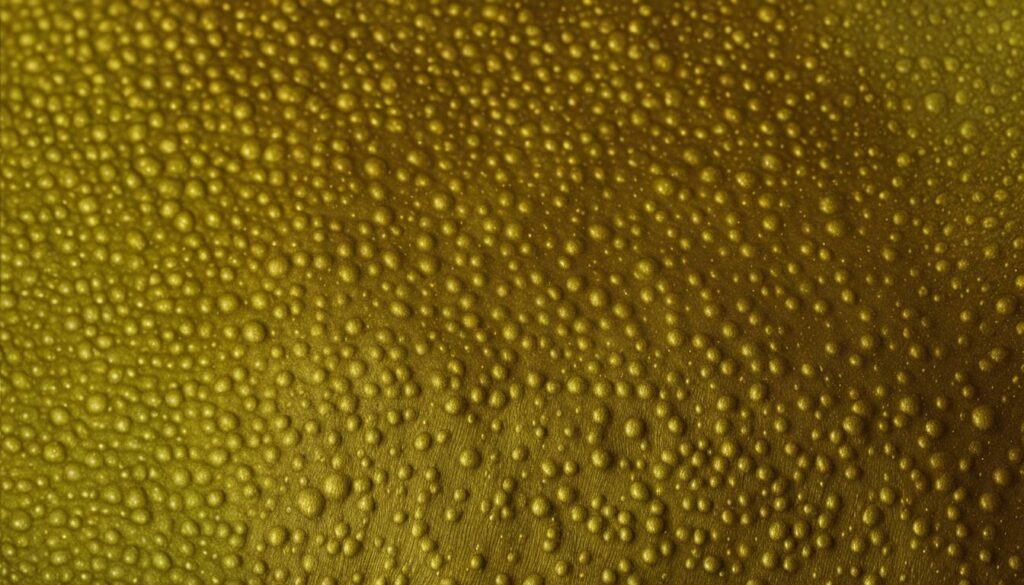
The Importance of Keeping Pillows Clean
Keeping pillows clean is essential for several reasons. Over time, pillows can accumulate allergens such as dust mites and mildew, which can cause allergic reactions and impact sleep quality.
Additionally, the sweat, oil, and dead skin cells that lead to yellow stains can clog pores and potentially cause skin breakouts.
Regular pillow maintenance and replacement every one to two years can help maintain a clean sleep environment and promote better sleep and overall health.
Effects of Dust Mites and Allergens on Sleep Quality
Dust mites are microscopic creatures that thrive in warm and humid environments like pillows. Their droppings can trigger allergies and respiratory issues, leading to disrupted sleep. By keeping pillows clean, you can reduce the presence of dust mites and allergens, creating a healthier sleep environment.
Potential Skin Breakouts from Sweat, Oil, and Dead Skin Cells
As you sleep, sweat, oil, and dead skin cells get transferred onto your pillows. These substances can clog pores and contribute to skin breakouts, especially if you have sensitive or acne-prone skin. By regularly cleaning your pillows, you can mitigate the risk of skin issues and maintain clearer, healthier skin.
The Role of Pillow Maintenance in Sleep Hygiene
Pillow maintenance is a vital aspect of sleep hygiene. By washing your pillows according to the manufacturer’s instructions, you can remove dirt, stains, and unpleasant odors, ensuring a fresh and clean sleep surface. Additionally, replacing pillows every one to two years can prevent the buildup of allergens and maintain optimal support for your head and neck.
| Benefits of Keeping Pillows Clean |
|---|
| Reduced risk of allergies and respiratory issues |
| Minimized potential for skin breakouts |
| Fresh and clean sleep environment |
| Maintained support for head and neck |
By prioritizing the cleanliness of your pillows, you can enjoy better sleep quality, improved skin health, and overall well-being. Don’t overlook the importance of keeping your pillows clean and consider establishing a regular pillow maintenance routine for a healthier sleep experience.
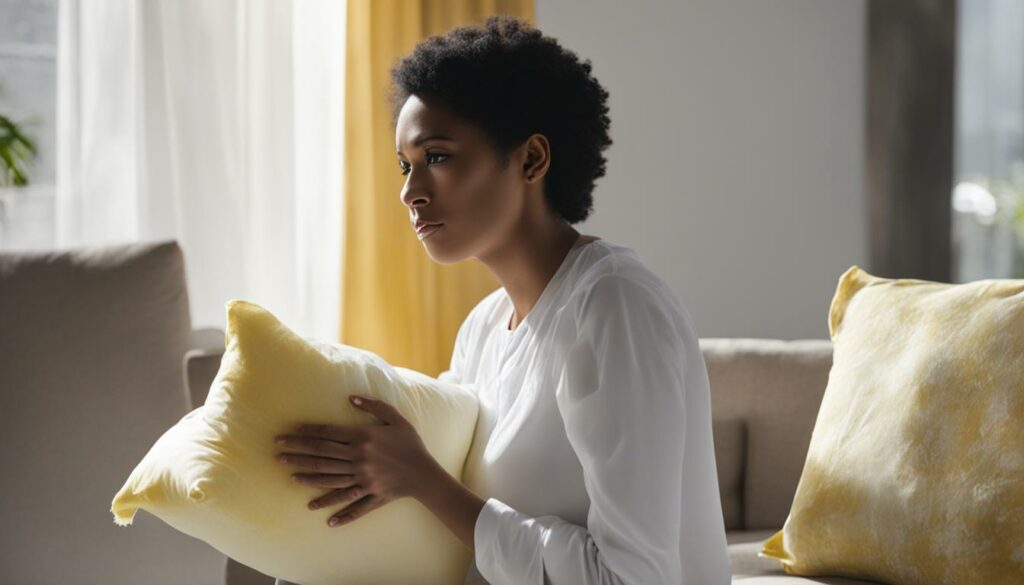
When to Replace Your Pillow
Knowing when to replace your pillow is crucial for maintaining a clean and healthy sleep environment. Over time, pillows can deteriorate and become less effective in providing comfort and support. Here are some key indicators that it may be time to replace your pillow:
- Excessive Discoloration: If you notice significant yellowing or discoloration on your pillow, it’s a sign that it has accumulated sweat, oils, and other substances over time. These stains can be difficult to remove and may indicate a buildup of allergens and bacteria.
- Musty Smell: A musty or unpleasant odor coming from your pillow suggests that it has absorbed moisture and developed mold or mildew. This can pose a risk to your respiratory health and should be addressed promptly.
- Lost Shape: If your pillow has lost its original shape and no longer provides the support and comfort it once did, it’s a clear indication that it’s time for a replacement. Flattened, lumpy, or uneven pillows can lead to poor sleep quality and discomfort.
- Age of the Pillow: Even with proper care, pillows have a limited lifespan. Experts generally recommend replacing pillows every one to two years, as they can accumulate allergens, lose their density, and become less hygienic over time.
By regularly assessing the condition of your pillow and being mindful of these signs, you can ensure that you are sleeping on a clean and supportive surface.
Signs It’s Time to Replace Your Pillow
| Signs | Indications |
|---|---|
| Excessive Discoloration | Sweat, oils, and stains are difficult to remove. |
| Musty Smell | Possible mold or mildew growth. |
| Lost Shape | Flattened, lumpy, or uneven appearance. |
| Age of the Pillow | Used for more than one to two years. |
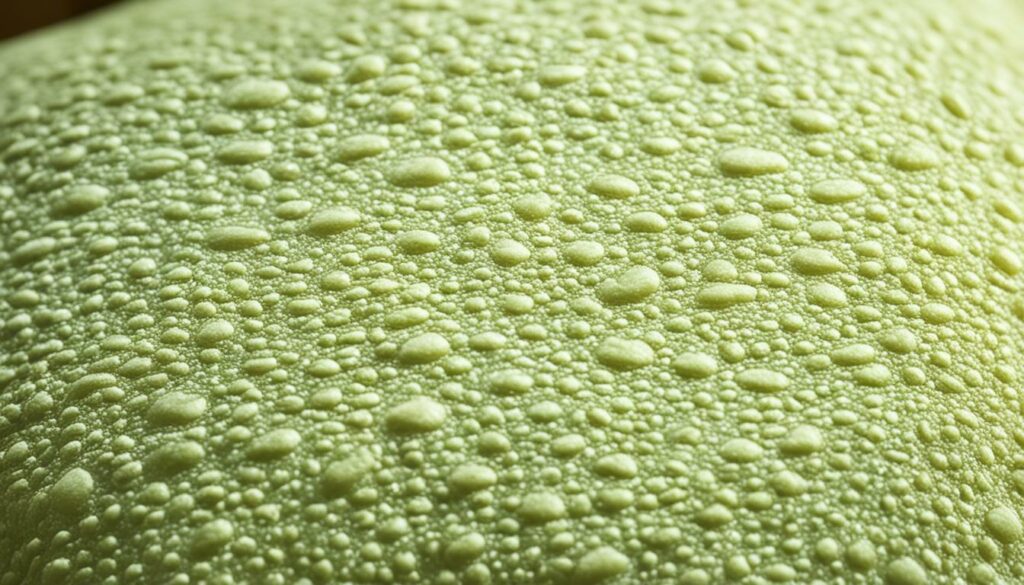
Using Pillow Protectors to Prevent Yellow Stains
Preventing yellow stains on your pillows is essential for maintaining their appearance and cleanliness. One effective method to achieve this is by using pillow protectors. These protectors act as a sealed layer of fabric between your pillowcase and the pillow itself, creating an additional barrier against moisture and preventing yellow stains from forming.
By using a pillow protector, you can prolong the lifespan of your pillow and keep it in pristine condition. The added layer of protection prevents sweat, drool, and other liquids from seeping into the pillow, thus avoiding the development of yellow stains. Additionally, pillow protectors also provide a defense against the accumulation of allergens, such as dust mites and pet dander, which can affect sleep quality and overall health.
Pillow protectors are available in various materials, such as cotton, polyester, and waterproof fabrics. Choose a protector that suits your preferences and needs. Waterproof pillow protectors are particularly beneficial as they offer an extra level of protection against spills and accidents, ensuring that your pillow remains clean and free from yellow stains.
Using a pillow protector is simple and straightforward. Here are the steps to follow:
- Insert the pillow into the protector, ensuring a snug fit.
- Place the pillow with the protector into your pillowcase as you normally would.
- Secure the pillowcase in place, covering the pillow and protector completely.
With the pillow protector in place, you can rest assured that your pillow is shielded from moisture and potential yellow stains. As an added bonus, pillow protectors are typically machine washable, making cleaning and maintenance a breeze.
Investing in pillow protectors is a simple yet highly effective way to prevent yellow stains and maintain the cleanliness of your pillows. By creating an additional barrier against moisture, these protectors ensure that your pillows stay fresh, comfortable, and free from unsightly discoloration.
By using pillow protectors, you can enjoy a clean and hygienic sleep environment while prolonging the lifespan of your pillows.
Tips for Washing Pillows to Remove Yellow Stains
Properly washing pillows is crucial for removing yellow stains and maintaining their cleanliness. By following the care instructions provided by the manufacturer, you can effectively restore the appearance of your pillows. Here are some tips to help you wash pillows and eliminate yellow stains:
- Read the care instructions: Before washing your pillows, always check the care instructions provided by the manufacturer. Different pillow materials may require different washing methods and temperatures, so it’s essential to follow the guidelines to avoid damaging the pillows.
- Spot-treat stains: If your pillows have yellow stains, spot-treating the affected area can help minimize their appearance. Apply a stain remover directly to the stain and gently rub it with a clean cloth or sponge. Let the stain remover sit for a few minutes before rinsing thoroughly.
- Wash in lukewarm water: To wash your pillows, use lukewarm water instead of hot water. Hot water can cause certain pillow materials to shrink or lose their shape. Set your washing machine to a gentle cycle to ensure a delicate yet effective cleaning process.
- Use a mild detergent: Choose a mild detergent specifically designed for delicate fabrics. Avoid using harsh chemicals or bleach, as they can damage the pillow fibers and lead to further discoloration. Read the detergent label to ensure it is suitable for your pillows.
- Opt for an extra rinse: To remove any detergent residue, consider running an extra rinse cycle. This helps to ensure that no soap suds remain in the pillows, which can cause skin irritation or discomfort while sleeping.
Remember, not all pillows are suitable for machine washing. Some types, such as memory foam or down pillows, may require special care or professional cleaning. Always refer to the manufacturer’s instructions or consult with a pillow specialist if you’re unsure about the washing method for your specific pillow type.
By following these tips and maintaining a regular washing routine, you can effectively remove yellow stains from your pillows and enjoy clean, fresh bedding for a good night’s sleep.
The Impact of Clean Pillows on Sleep Quality
Maintaining clean pillows can have a significant impact on your sleep quality. When your pillows are clean, they create a healthier sleep environment by removing allergens and preventing the accumulation of sweat, oil, and dead skin cells. This not only enhances your comfort but also promotes better sleep, improved immune function, and overall well-being.
When your pillows are free from dirt and contaminants, you can breathe easier and reduce the risk of allergic reactions. Dust mites, mold, and other allergens thrive in dirty bedding, which can exacerbate respiratory conditions and disrupt your sleep. By regularly washing or replacing your pillows, you can minimize these allergens and enjoy a more restful night’s sleep.
Apart from allergens, the accumulation of sweat, oil, and dead skin cells on your pillows can also lead to adverse effects on your skin. Dirty pillows can clog pores, potentially causing skin breakouts and irritation. Keeping your pillows clean ensures that your skin remains healthy and rejuvenated.
Moreover, the overall cleanliness and freshness of your pillows contribute to creating a relaxing sleep environment. The scent and feel of clean pillows can help you unwind and prepare for a restful night’s sleep. The absence of unpleasant odors and stains enhances your comfort and promotes relaxation.
To maintain clean pillows, it is important to follow proper pillow maintenance practices. Regularly washing your pillows according to the care instructions and using pillow protectors can help prevent the buildup of dirt and stains. Furthermore, replacing your pillows every one to two years ensures that you have a clean and supportive sleep surface.
By prioritizing the cleanliness of your pillows and incorporating regular care and maintenance into your sleep routine, you can experience the positive impact of clean pillows on your sleep quality and overall well-being.
The Lifespan of Pillows
Pillows, just like any other household item, have a limited lifespan. It’s important to understand when to replace them to ensure optimal sleep hygiene and a clean and supportive sleep surface. While the lifespan of pillows can vary depending on various factors, it is generally recommended to replace them every one to two years.
Over time, pillows accumulate sweat, dirt, allergens, and bacteria. These factors can not only affect the cleanliness and appearance of the pillows but also impact sleep quality and overall health. As pillows age, they may lose their shape and support, causing discomfort during sleep.
To prolong the lifespan of your pillows, regular maintenance is crucial. Washing your pillows according to the manufacturer’s instructions can help remove dirt, sweat, and allergens, keeping them clean and fresh. Additionally, using pillow protectors can act as a barrier against moisture, preventing yellow stains and prolonging the lifespan of your pillows.
However, even with proper maintenance, pillows will eventually lose their integrity and efficacy. It’s important to pay attention to signs that indicate it’s time for replacement. If your pillow has become lumpy, flat, or has an unpleasant odor that cannot be eliminated, it’s a clear indication that it needs to be replaced.
Remember: Your pillow should provide the support and comfort necessary for a good night’s sleep. If you find yourself constantly adjusting or folding your pillow to get comfortable, it’s a sign that it’s time for a replacement.
When it’s time to replace your pillow, consider donating it to a local shelter or recycling it responsibly to minimize environmental impact.
| Signs it’s time to replace your pillow: | Reasons for replacing your pillow: |
|---|---|
| 1. Loss of shape and support | 1. Discomfort during sleep |
| 2. Lumpy or uneven texture | 2. Accumulation of sweat, dirt, allergens, and bacteria |
| 3. Unpleasant odor that cannot be eliminated | 3. Reduced sleep quality |
| 4. Difficulty getting comfortable | 4. Allergic reactions or skin irritations |
Knowing when to replace your pillow is essential for maintaining a clean and healthy sleep environment. By replacing your pillow every one to two years, you ensure that you are getting the support, comfort, and cleanliness necessary for a good night’s sleep.
Tips for Pillow Maintenance
Proper maintenance of pillows is crucial for keeping them clean and prolonging their lifespan. By following these simple tips, you can ensure that your pillows stay fresh and comfortable for a long time.
1. Use Pillow Protectors
Using pillow protectors is a great way to maintain clean pillows. These protectors act as a barrier between your pillow and potential stains caused by sweat, oils, and skincare products. They are easy to wash and can be reused multiple times, providing an added layer of protection for your pillows.
2. Wash Pillows Regularly
Regular washing is essential for keeping your pillows clean and free from dust, allergens, and yellow stains. Consult the care instructions provided by the manufacturer to determine the appropriate washing method for your specific type of pillow. Remember to use a gentle cycle and mild detergent to preserve the pillow’s integrity.
3. Spot-Treat Stains
If you notice any stains on your pillows, it’s important to address them promptly. Spot-treating stains with a mild cleaning solution can help remove stubborn marks and prevent them from setting deeper into the fabric. Gently blot the stain with the cleaning solution and a clean cloth, then let it air dry.
4. Proper Bedtime Hygiene
Practicing good bedtime hygiene can contribute to maintaining clean pillows. Showering before bed removes excess oils and dirt from your body, preventing them from transferring onto your pillowcase. Additionally, avoid applying excessive skincare products before sleeping to reduce the chance of stains and residue on your pillows.
Following these pillow maintenance tips will help you maintain clean and fresh pillows, ensuring a comfortable and hygienic sleep environment. Take care of your pillows, and they will take care of you!
Conclusion
The yellow stains that appear on pillows are a common problem caused by the accumulation of moisture from sweat, drool, wet hair, and skincare products. These stains not only affect the appearance of your pillows but also create a breeding ground for bacteria and allergens, which can impact your sleep quality and overall health.
To prevent yellowing and keep your pillows clean and healthy, it is essential to use pillow protectors, regularly wash your pillows following care instructions, and maintain proper hygiene practices. Pillow protectors act as a barrier, protecting your pillows from moisture and stains. Regular washing helps remove sweat, oil, and dead skin cells that contribute to discoloration. And practicing good hygiene habits, such as showering before bed and avoiding excessive use of skincare products, can greatly reduce the occurrence of yellow stains.
If yellow stains do appear on your pillows, don’t worry. Spot-treating the stains by applying a cleaning agent and following the care instructions can help remove them. It’s important to note that each pillow has specific care guidelines, so be sure to read and follow them carefully to avoid damaging your pillows. By practicing proper pillow maintenance and timely replacement, you can create a clean and supportive sleep environment that contributes to your overall well-being.
FAQ
Why are my pillows turning yellow?
Pillows can turn yellow due to the accumulation of moisture from sweat, drool, wet hair, and skincare products. These stains are not only unsightly but can also harbor bacteria and allergens, affecting the quality of sleep and overall health.
What are the causes of yellow pillow stains?
The most common cause of yellow stains on pillows is the accumulation of moisture from sweat, drool, wet hair, and skincare products. These factors contribute to the growth of bacteria and allergens, leading to pillow discoloration.
How can I prevent yellow stains on my pillows?
To prevent yellow stains, you can use a pillow protector, sleep in a cooler room, wear lighter pajamas, avoid going to bed with wet hair, address the causes of drooling, and limit the use of skincare products before bedtime.
How do I remove yellow stains from my pillows?
To remove yellow stains, follow the care instructions provided by the manufacturer. You can spot-treat stains, apply a cleaning agent, wipe it off, and use bleach if safe for your pillow. However, it is important to understand the specific care guidelines for each pillow.
Why is it important to keep pillows clean?
Keeping pillows clean is important to remove allergens, such as dust mites and mildew, which can cause allergic reactions and impact sleep quality. Additionally, sweat, oil, and dead skin cells that lead to yellow stains can clog pores and potentially cause skin breakouts.
When should I replace my pillow?
It is recommended to replace your pillow every one to two years or when it has excessive discoloration, a musty smell, or has lost its shape. Regular replacement ensures a clean and healthy sleep environment.
How can pillow protectors prevent yellow stains?
Pillow protectors act as a barrier between the pillowcase and the pillow, preventing moisture accumulation and reducing the risk of yellow stains. By using pillow protectors, you can maintain the appearance and cleanliness of your pillows.
What are the tips for washing pillows to remove yellow stains?
When washing pillows, read the care instructions provided by the manufacturer. Spot-treating stains, using stain removers, washing in lukewarm water on a gentle cycle, and soaking in bleach if safe for your pillow are effective methods for removing yellow stains.
What is the impact of clean pillows on sleep quality?
Clean pillows remove allergens and prevent the accumulation of sweat, oil, and dead skin cells, creating a healthier sleep environment. This can result in better sleep, improved immune function, and overall well-being.
What is the lifespan of pillows?
Pillows should be replaced every one to two years for optimal sleep hygiene. Over time, pillows accumulate sweat, dirt, allergens, and bacteria, which can impact sleep quality and overall health.
What are some tips for pillow maintenance?
To maintain clean pillows, use pillow protectors, follow care instructions, spot-treat stains, regularly wash or replace pillows, shower before bed, and avoid excessive use of skincare products to prevent yellow stains and promote sleep hygiene.
Eric Christie stands as a luminary in the bedding industry, with a career spanning nearly four decades since the early 1980s. His journey through the world of bedding has seen him wear many hats – a manufacturer, designer, and retailer, showcasing his versatility and expertise in Read more...


